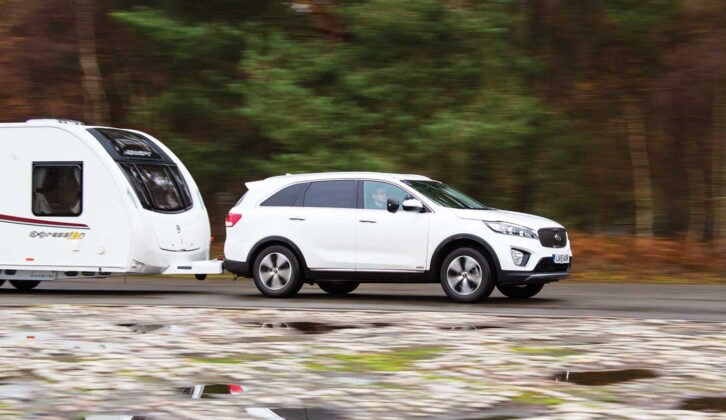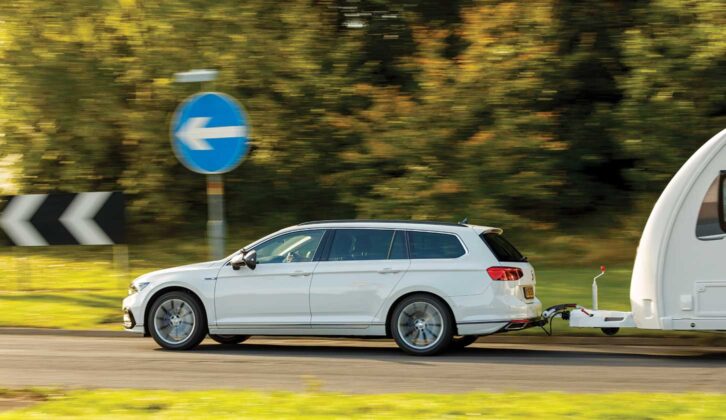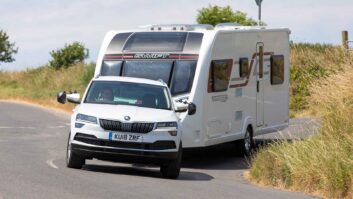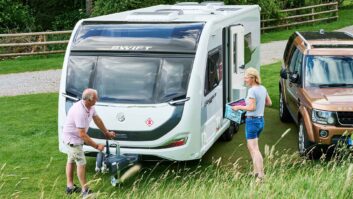Matching a car to a caravan can feel like a daunting prospect. After all, you’re essentially doubling the length of your car (if not more), adding over one-and-a-half tonnes to the weight, and then adding a great big hinge in the middle.
Staying safe on the road starts with making sure you have a sensibly matched caravan and tow car. To do that, you’ll have to check the weights and legal limits of your car and the caravan – once you’ve done this, you’ll be well placed to start thinking about the best caravan tow cars.
In this guide, we explain what you need to know about matching a car and a caravan for towing, so you can have a relaxed, safe and legal towing experience.
What do I need to know to safely match a car with a caravan?
Whether you’re buying in a new model or prefer one of the best used tow cars, the same rules will apply. Begin by checking the car’s kerbweight, the maximum download on the towball (also called the maximum noseweight), and the car’s legal towing limit.
Moving onto the tourer, find out the Mass in Running Order (MiRO) and also the Maximum Technically Permissible Laden Mass (MTPLM) – we explain what these terms mean in our guide to caravan weights.
Some automotive manufacturers refer to the kerbweight as the unladen weight or the mass in running order. Whatever term is used, you’re looking to find out what the car weighs according to European Directive 95/48/EC, which includes all the fluids necessary for the car to run and a 90% full tank of fuel.
Sometimes this figure is given including a nominal 75kg for the driver, sometimes without. Given that a car isn’t going anywhere without someone behind the wheel, it seems reasonable to allow for the driver’s weight when matching a car with a caravan.

You should be able to find how much a car weighs in the sales brochures or in its handbook. Alternatively, you can check the registration certificate (V5C).
If in any doubt, you could take your car to a weighbridge to confirm how much it weighs without any luggage or passengers on board.
The legal towing limit is also given in most brochures and handbooks. There are likely to be two figures, one for towing an unbraked trailer, one for towing a braked trailer – a caravan has brakes, so it’s the braked trailer figure you need.
Now for the caravan. The MiRO (Mass in Running Order) and MTPLM (Maximum Technically Permissible Laden Mass) should both be given in any brochure or in its online listing, or you’ll find them on the weight plate on the side of the caravan.
The MiRO is the caravan equivalent of the kerbweight, the MTPLM is the most the caravan can weigh when loaded.
With the majority of caravanners towing at or close to the MTPLM, it’s best to use this figure for outfit matching.
How do I make sure I am towing legally?
Following a change to the law in December 2021, most people will have the right licence for towing a caravan. Now, anyone with a full UK driving licence will be able to tow a tourer which has a weight of up to 3500kg MAM (Maximum Authorised Mass).
That’s the licence part sorted. When it comes to towing legally, the short answer is that if your caravan weighs less than the car’s legal towing limit, then the car and caravan combination is legal.
Even if your caravan has an MTPLM below the car’s legal towing limit, it’s worth checking the weights given on your car’s VIN plate. There should be four, and it’s the first two you’ll need to pay close attention to.

The first is the Gross Vehicle Weight (GVW), the most the car is allowed to weigh when loaded. The second is the Gross Train Weight, the most the car and any caravan or trailer can weigh combined.
In most cases, the difference between the two should be equal to the legal towing limit given in the handbook and brochure. However, some manufacturers quote a legal towing limit with just the driver on board. So when you load up your car, the effective towing limit drops.
Make sure you don’t exceed the Gross Train Weight to stay on the right side of the law.
Once you’re out on the road, don’t forget aids like the best caravan sat navs either – these can help you enjoy a stress-free experience when you’re towing.
Is a legal match a safe match?
A car’s legal towing limit is determined by its ability to tow a trailer – or caravan – uphill, repeatedly. So it’s really a measure of the strength of the tow car engine and the durability of the transmission.
It doesn’t necessarily mean a car will feel stable and secure towing that much weight when it hits the caravan speed limit of 60mph on the motorway with a gusty wind blowing for company.
The two major caravanning clubs both recommend an 85% matching ratio for safe, stable towing.
In other words, if your car has a kerbweight of 1500kg, don’t tow a caravan weighing more than 1275kg (1500 multiplied by 0.85). This is often referred to as ‘the 85% rule’, but it’s a guideline or rule of thumb, rather than a legal requirement.
The club considers it acceptable for experienced tow car drivers to tow up to 100% of the tow car’s kerbweight, but never more than this – even if it’s legal to do so.
What about noseweight?
We’ll start with a definition of exactly what this is – the noseweight is the weight the towing hitch of the caravan applies to the towball on the car. Cars have maximum noseweights, just as they have maximum towing limits.
This is something you should be able to find by looking in the car’s handbook.
For safe and stable towing, the noseweight should be as high as possible without exceeding the legal maximum. Something that can help you here will be investing in a noseweight gauge – with one of these, you’ll find it much easier to check the noseweight applied by a caravan.
Changing how you’re loading a caravan will also alter the noseweight, but if the car’s limit is too low it may not be possible to stay within the maximum download, in which case you’ll need a tow car with a higher noseweight limit, or a lighter caravan.
The final word on matching a car to a caravan for towing
When you’re matching a car to a caravan, it’s worth taking your time to make sure you’re going to be able to tow your tourer safely.
Start by checking that your car can legally tow the caravan you are thinking of buying.
Next, check the matching ratio to reassure yourself that the combination will be stable and safe, as well as legal – don’t forget to measure the noseweight to make sure the towball’s limit is not exceeded either.
You’ll then be perfectly placed to enjoy safe towing on the road, but you can also take a look at our top caravan towing tips more guidance.
If you’ve enjoyed reading this article, why not get the latest news, reviews and features delivered direct to your door or inbox every month. Take advantage of our brilliant Practical Caravan magazine SUBSCRIBERS’ OFFER and SIGN UP TO OUR NEWSLETTER for regular weekly updates on all things caravan related.









